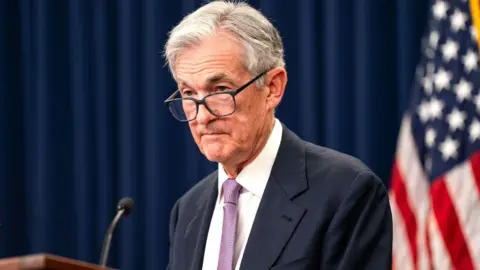 Getty Images
Getty ImagesThe head of the US central bank has hit back at speculation that his post might be in jeopardy as Donald Trump prepares to assume power in Washington.
Federal Reserve chairman Jerome Powell said he would not step down if Trump asked and that it is “not permitted under law” for the White House to force him out.
Mr Powell was responding to questions from reporters at a press conference after the bank announced a cut to borrowing costs, lowering the Fed’s key lending rate to the range of 4.5%-4.75%.
Forecasters have been expecting borrowing costs to fall further in the months ahead but warned that Trump’s plans for tax cuts, immigration and tariffs could keep pressure on inflation and drive up government borrowing, complicating those bets.
Trump has pledged to impose import duties of at least 10% on all goods coming into the country, costs that economists say would be passed onto consumers, helping to drive up prices.
Tax cuts could also stoke inflation by encouraging spending, while the mass deportations of immigrants proposed by Trump would create a big hole in the US workforce that could drive up wages.
Interest rates on US debt have already jumped this week, reflecting those concerns.
Mr Powell said on Thursday that it was too early to tell how the new administration’s agenda might affect the US economy – or how the Fed should respond.
“It’s such an early stage – we don’t know what the policies are, we don’t know when they will be implemented,” he said. “In the near term, the election will have no effects on our policy decisions.”
Mr Powell was named chairman of the Fed by Trump in 2017, but later became a frequent target of his criticism.
During his first term, Trump called bank officials “boneheads” on social media and reportedly consulted advisers about whether he could fire Mr Powell.
This year, US media have reported that Trump allies have been looking at ways for the White House to assert more control over the Fed, including potentially sidelining Mr Powell by prematurely naming his replacement.
Trump has said repeatedly he believes he has the right to voice his views on Fed actions. He told Bloomberg over the summer that he would let Powell serve out his term, which ends in 2026, “especially if I thought he was doing the right thing”.
However, Powell said on Thursday that he would not step down if ordered to by Trump, and that an attempt to oust him before his term is over is “not permitted under the law”.
Mr Powell has faced heavy scrutiny over the last few years, as prices started surging in 2022.
The bank responding by hiking rates rapidly that year, ultimately raising them from near zero to roughly 5.3% as of July – the highest rate in more than two decades.
Those rises affected the public in the form of higher borrowing costs for credit cards, mortgages and other loans, helping to fuel discontent about higher living costs, especially for housing, that played a role in the election.
The Fed started to reverse course in September, slashing rates by a bigger-than-usual 0.5 percentage points, saying it was confident that the pace of price rises in the US was stabilising.
Inflation in the US stood at 2.4% in September, down from more than 9% in June 2022, according to the latest official figures.
The cut announced on Thursday, which was widely expected and unanimous, marked the second drop in a row, lowering rates by a further 0.25 percentage points.
Mr Powell said on Thursday officials remained equally focused on keeping prices stable and the job market healthy.
Though concerns flared earlier this year about rising unemployment, those quietened in September, after data showed an unexpectedly strong burst of hiring.
However, the latest figures showed almost non-existent job growth in October, when the country was grappling with hurricanes and strike actions.
Mr Powell said officials expected to continue to cut rates, but how fast and how far remained to be seen. He resisted questions seeking more precise guidance.
“We don’t think it’s a good time to be doing a lot of further guidance – there’s a fair amount of uncertainty,” he said. “The point is to find the right pace and destination as we go.”
Whitney Watson, co-chief investment officer of fixed income at Goldman Sachs Asset Management, said her firm expected to see another rate cut in December, but acknowledged questions about the path ahead.
“Stronger data and uncertainty over fiscal and trade policies mean rising risks that the Fed may opt to slow the pace of easing,” she said, noting that the central bank might start to “skip” rate cuts next year.
The decision by the Fed came the same day that the Bank of England warned that it could take longer for borrowing costs to fall, warning that inflation could creep higher after last week’s Budget.
“On both sides of the pond, we are seeing expectations for future rate cuts being scaled back considerably compared to what many had originally hoped for,” said Lindsay James, investment strategist at Quilter Investors.
“In the US, it seems interest rates will stay higher for longer as the Fed will need to tread very carefully until it is better able to assess the true impact of Trump’s plans.”

